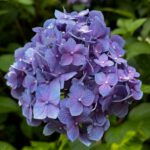Hydrangea
$170.00
The Hydrangea (Hydrangea macrophylla) is a stunning and adaptable plant that adds beauty and sophistication to any garden or floral arrangement. Its large, colorful blooms, versatile growing habits, and extended flowering season make it a popular choice for enhancing your outdoor and indoor spaces.
Hydrangeas are elegant and versatile flowering shrubs known for their large, globe-like flower clusters and lush foliage. With their ability to adapt to different soil types and colors, Hydrangeas bring beauty and charm to gardens and floral arrangements.
Key Features:
- Large, Lush Blooms: Hydrangeas are famous for their impressive flower heads that can range from soft pastels to vibrant hues, including pink, blue, purple, and white. The blooms can change color based on soil pH, adding a dynamic element to your garden.
- Versatile Varieties: Available in various types, including mophead, lacecap, and panicle Hydrangeas. Each type offers unique flower shapes, sizes, and colors to suit different gardening styles and preferences.
- Long-Lasting Flowers: Hydrangeas have a long flowering season, typically from mid-summer to fall, providing extended color and interest in your garden.
Plant Care:
- Watering: Hydrangeas require regular watering to keep the soil consistently moist, especially during dry spells. Ensure the soil is well-draining to prevent waterlogging and root rot. Mulching around the base can help retain soil moisture and regulate temperature.
- Light: Thrives in partial shade to full sun. While they can tolerate some direct sunlight, they generally prefer a spot with morning sun and afternoon shade to protect from the intense midday heat. Too much sun can cause wilting and reduce flowering.
- Soil: Prefers well-draining, fertile soil enriched with organic matter. Hydrangeas benefit from slightly acidic to neutral soil. Amend the soil with compost or peat moss to improve its structure and nutrient content.
- Temperature: Enjoys moderate temperatures and can tolerate a range of climates. In colder regions, protect from harsh winter winds and consider mulching around the base to insulate the roots.
- Humidity: Average humidity levels are suitable for Hydrangeas. They are adaptable to various environmental conditions but benefit from good air circulation to prevent fungal issues.
- Maintenance: Prune after flowering to shape the plant and remove any dead or damaged stems. For mophead varieties, avoid heavy pruning as they bloom on old wood. Fertilize in early spring with a balanced, slow-release fertilizer to support healthy growth and blooms. Adjust soil pH as needed to influence flower color.
Tip: Hydrangeas are versatile and can be used in garden beds, borders, or as focal points. For container planting, choose a large pot with good drainage and ensure regular watering to keep the plant healthy and vibrant.
Related products
The Rhododendron (Rhododendron spp.) is a stunning and versatile shrub that adds elegance, color, and year-round interest to any garden or landscape. Its spectacular blooms, evergreen foliage, and varied sizes make it a cherished choice for enhancing outdoor spaces.
The Begonia (Begonia spp.) is a delightful and versatile plant that adds a touch of color and elegance to any space. Its diverse varieties, stunning foliage, and beautiful blooms make it a popular choice for both home and garden enthusiasts.
The Lavender (Lavandula spp.) is a beautiful and practical addition to any garden or indoor space, offering both visual appeal and aromatic benefits. Its fragrant blooms, evergreen foliage, and versatility make it a cherished plant for enhancing your home and garden.
The Tulip (Tulipa spp.) is a classic and beloved flower that adds elegance, color, and charm to any spring garden or floral arrangement. Its beautiful blooms, diverse forms, and early blooming period make it a favorite among gardeners and flower enthusiasts alike.
The Oleander (Nerium oleander) is a beautiful and resilient shrub that brings vibrant color and lush greenery to any garden or landscape. Its stunning flowers, evergreen foliage, and low-maintenance nature make it an excellent choice for enhancing outdoor spaces with minimal effort.









Reviews
There are no reviews yet.